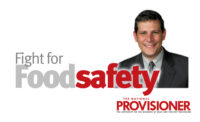Fight for Food Safety
A shift to Salmonella scrutiny

It appears increasingly likely that we are approaching another major shift in food safety regulation. The shift in this case would be the declaration of Salmonella as an adulterant in raw meat and poultry. Historically, major shifts tend to follow a cyclical pattern.
The most notable example of a major shift is what took place in the 1990s. The catalyst in that instance was the Jack-in-the-Box E. coli outbreak, perhaps the most consequential event in the history of American food safety. The national discourse following the outbreak — which sickened more than 600 people — led to increased regulatory scrutiny. The U.S. Department of Agriculture (USDA) declared E. coli O157:H7 an adulterant in ground beef, mandated hazardous analysis and critical control point (HACCP) programs, safe handling labels and E. coli O157:H7 testing. At the same time, Internet technology facilitated the creation of Pulsenet, a national foodborne illness surveillance system. One of Pulsenet’s enduring legacies is the revelation that foodborne illness was far more prevalent than previously believed. The increased regulatory scrutiny and improved understanding of foodborne illness ushered in a sustained period of innovation. In time, foodborne illness and its prevention were dramatically improved (especially as it related to the meat industry).
Another shift took place more recently. The catalyst in that instance was an increase in the number of outbreaks and recalls that can be directly attributed to programs such as Pulsenet and the Reportable Food Registry, both of which emerged in the preceding shift. Ironically, the increase of outbreaks and recalls (the result of better technology and oversight) created the perception that food was less safe when in fact outbreaks were just more likely to be identified. Nevertheless, the perception led to additional public discourse, which was followed by increased regulatory scrutiny: the Food Safety Modernization Act (FSMA).
Since FSMA became law, there has been another spike in high-profile recalls. This is likely because of increased regulation, better surveillance and further technological advances. Notably, there has been an increase in Salmonella-related recalls. In the past, recalls of raw meat and poultry stemming from Salmonella were very rare. Although FSIS expects companies to recall products linked to illness, Salmonella is not classified as an adulterant in raw meat and poultry. The increase in recalls may portend the declaration of Salmonella (or at least the most virulent strains) as an adulterant.
In 2018, there were numerous high-profile Salmonella recalls and outbreaks. Another tell-tale sign of a shift is the discernible uptick in calls for Salmonella to be declared an adulterant in raw meat and poultry. Any major Salmonella event could provide the requisite catalyst to reach the critical mass necessary to bring about the change.
As outbreak surveillance continues to improve, outbreaks and recalls may also continue to increase. This would further enhance the likelihood of a major shift. Salmonella remains on the USDA’s Food Safety and Inspection Service (FSIS) radar, so processors should prepare to be targeted if Salmonella in their products cause illness. NP
Looking for a reprint of this article?
From high-res PDFs to custom plaques, order your copy today!









